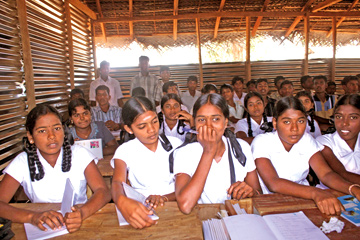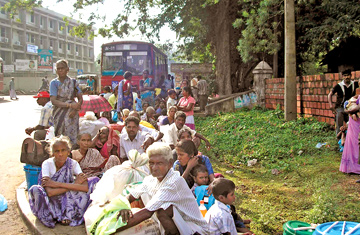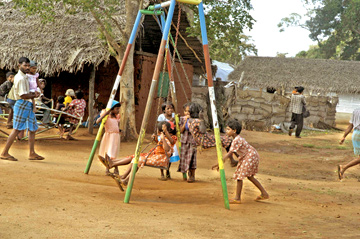A beacon of light for IDPs
* As at November 25, 2009 the number of
Internally Displaced Persons remain at Welfare Centres 128,616.
* Total number of people released from
welfare centres and resettled 139,131.
by Dhaneshi YATAWARA
It was May 14, 2009. It was the height of the battle against LTTE
terrorists and the Sri Lanka Army was manoeuvring their operations with
utmost care. It was not just a war against LTTE, the core issue was to
rescue the unarmed civilians trapped in the last `No Fire Zone' in
Puthumathalan. Thousands of people waded through the Nandikadal Lagoon
carrying the weak-children, elders, sick and pregnant mothers with them.
The LTTE fired using the deadly paddle gun, targeting the civilian
landing point on the other side of the lagoon where the soldiers took
them to safety.
The fight was not against Tamil civilians. It was purely to 'purge'
LTTE terrorism forever. Encountering enormous difficulties the civilians
escaped the impenetrable LTTE obstacles.
Soldiers saved the lives of over 283,000 civilians (91,000 families)
during the time spanning from mid November, 2008 to mid May 2009.
Soldiers never took these civilians as a burden. They even gave their
own food to these escapees and cared for the sick and the weak alike.
The biggest challenge
The large influx of people within a short span was the first greatest
challenge the Government faced during this time. It was a formidable
task for the Government. "Though the exodus of civilians was not easily
manageable yet such sort of a situation was nothing new to the
Government," said Chandra Fernando, Presidential Advisor on North and
East and Senior member of the Presidential Task Force on Northern
Development explaining that the experience gained from the Eastern
Revival was significant at this juncture.
"Every detail was pre-planned to ensure the safety of the IDPs
adhering to the Geneva Convention to which Sri Lanka is a signatory. We
were ready to receive the Internally Displaced Persons and what we did
not know was only the actual number of the target group," he explained.
Parallel to these events de-mining was initiated. The utmost
importance in the Northern Development is security, protection and human
rights.
De-mining
At the initial stage the Government relied on the Sri Lanka Army to
expedite the de-mining process so as to create areas suitable for human
habitation. Several other Non-Governmental organizations are engaged in
the de-mining process now expecting to complete areas set apart for
them. The 'Sappers' - the Engineering Corps of the Sri Lanka Army has
already completed its mission. Their dedication to the job was a good
back up for the Government's mega resettlement programme.
According to Presidential Advisor Chandra Fernando seven
International agencies were entrusted with the task of de-mining
locations earmarked by the Government. The entire development drive,
which is now on full swing, is entirely conducted under the guidance of
Senior Presidential Advisor Basil Rajapaksa.
Fernando further said that as the de-mining agencies had to train
local staff according to the requirements, the process was rather slow.
With the intervention of the Sri Lanka Army 'Sappers', the situation was
improved. Next step was to purchase de-mining machines to speed up the
process in order to start resettlement. At present, a total of 25
de-mining machines are in operation in the North.
"The Task Force works on the four D's," Fernando explained.
"Demilitarization, Development, Democratization and Devolution! This is
the basic principle we follow in the Wadakkin Wasantham program," he
added.
Streamlining facilities

A temporary school in Cheddikulam Welfare Centre |

At Pudukudiyiruppu soldiers taking an old, woman to a safety
location during the final stages of the war |

IDPs waiting to return to their homes |

Children’s playground at a welfare centre |

Receiving medical treatment |
Due to the prolonged exposure to terrorism the Northern
Administration was severely handicapped. In order to streamline the
facilities provided to the IDPs the Government appointed Major General
G.A. Chandrasiri as the Competent Authority for IDPs with effect from
April 23, 2009.
When Maj. Gen. G.A. Chandrasiri was appointed the Governor Northern
Province, Maj. Gen. Kamal Gunarathne, the Wanni Security Forces
Commander, was appointed as the Competent Authority for IDPs.
The Government took all necessary measures to streamline the support
network for the IDPs. Six welfare villages were set up in Menik Farm,
situated along the Mannar-Vavuniya Road by the Government and later the
International Non-Governmental Organisations provided assistance.
"The local authorities of the Northern Province were facing threats
from the LTTE and they feared working openly and freely before the end
of the war," Maj. Gen. Chandrasiri said.
"Eliminating terrorism was significant in the restoration of civil
administration in the Province," he reiterated.
The resettlement of new IDPs was initiated on March, 2009. Elderly
people over 60 were given permission to leave the centres to join their
next of kin. So far, 9,633 elderly men and women have been released.
Orphaned children were taken care of, by the Government in directing
them to children's homes and to the families of their next of kin.
A total of 1,064 children were living among the IDPs without their
lawful guardians. As there were University students living among the
IDPs the authorities took the decision to release all of them.
349 youth were sent back to the Universities with special
arrangements made for them.
Today around 139,131 people have been resettled in almost all the
districts of the Northern Province. As at November 25, the total number
of IDPs sheltered in Welfare centres is 128,616.
All these people are provided with the proper Identity Cards on
President Mahinda Rajapaksa's directive restriction placed on the
movement of these people, out of their Welfare Centres, has is been
lifted with effect from December 1. The Government is in the process of
resettling all IDPs before end of January, 2010.
The initial resettlement started in Musali Divisional Secretariat
Division in Mannar.
The resettlement was based on three stages as per the plans of the
Presidential Task Force on Northern Development - i.e. Road clearing,
De-mining and Repairing and rebuilding damaged public buildings. Police
stations are being set up in each town leaving the security forces only
in strategic locations.
One major effect of the war is the creation of vulnerable groups who
lost their sustenance. Economically deprived people who find it
difficult to satisfy their minimum basic requirements are in a
vulnerable position. They include the landless poor farmers, casual
workers and daily wage earners.
With the elimination of terrorism the degree of vulnerability
declined thus making a favourable environment for resettling people to
allow them to re-engage in their normal economic activities in the
agriculture, animal husbandry, fisheries and other informal sectors.
This definitely ensures the dignity of these settlers. Facilitating
restoration of sustainable livelihood through opening income avenues and
providing other ancillary services, is in the main focus.
The Sri Lankan Government initiated the task of rebuilding the entire
war torn North while the Sri Lanka Army continued their humanitarian
mission entering the last stages of the war in the Pudukuduyirippu,
Puthumathalan and Vellamullivaikkal general areas in the Northeastern
corner of the Mullaitivu district. Today the entire area is clear from
all traces of terrorism.
The area is getting back to proper shape shedding the ugly hostages
of war. It is the soldier who makes the land suitable for the habitation
of its original settlers.
It's a new era speeding towards a prosperous nation. At this juncture
Sri Lanka needs to launch its post war reconstruction priorities at an
accelerated pace. Having faced the huge task of developing the entire
Northern Province following the return of the East to the national
mainstream, the Government has given the top priority to the development
drive in the rest of the country. |

